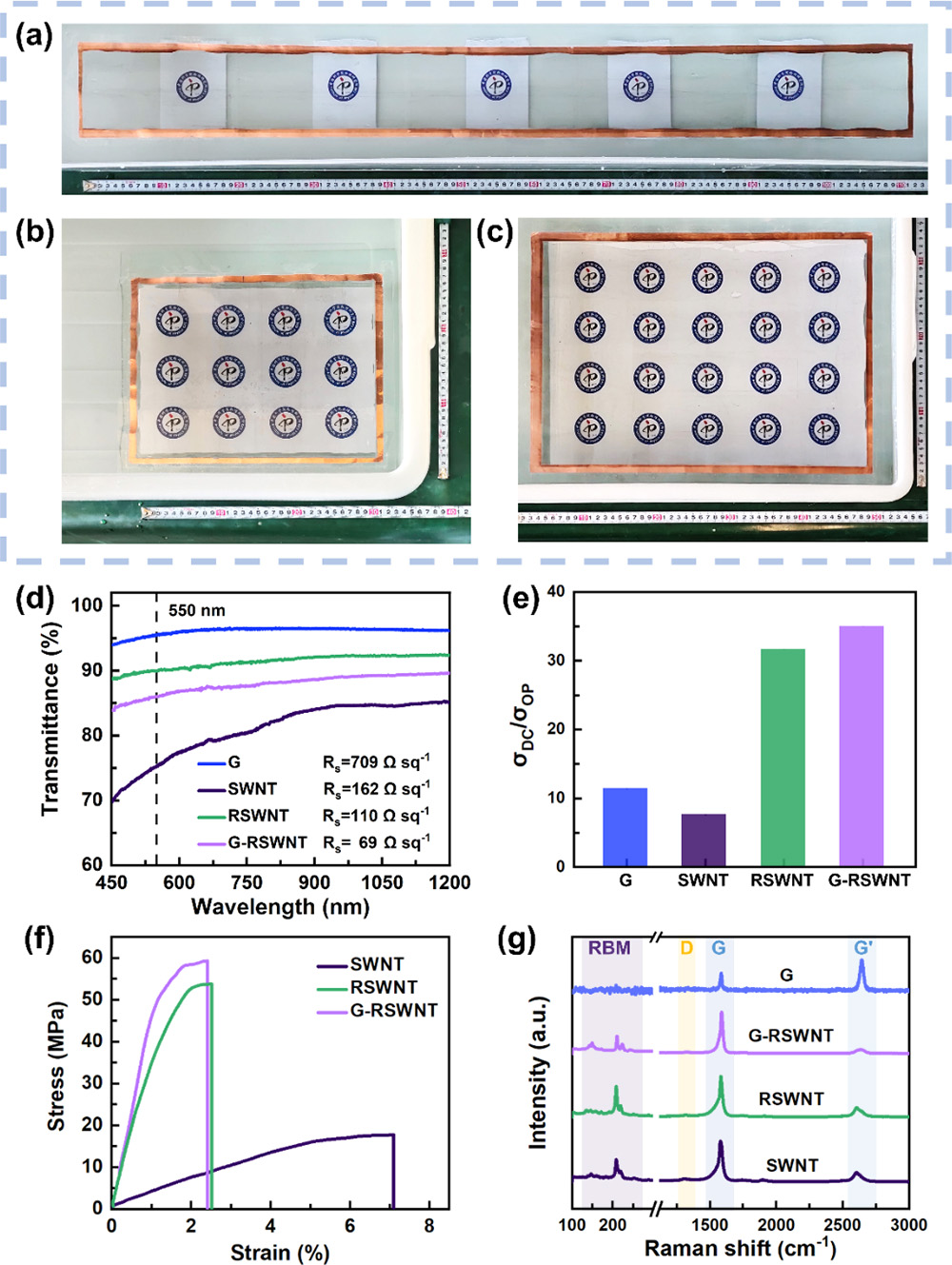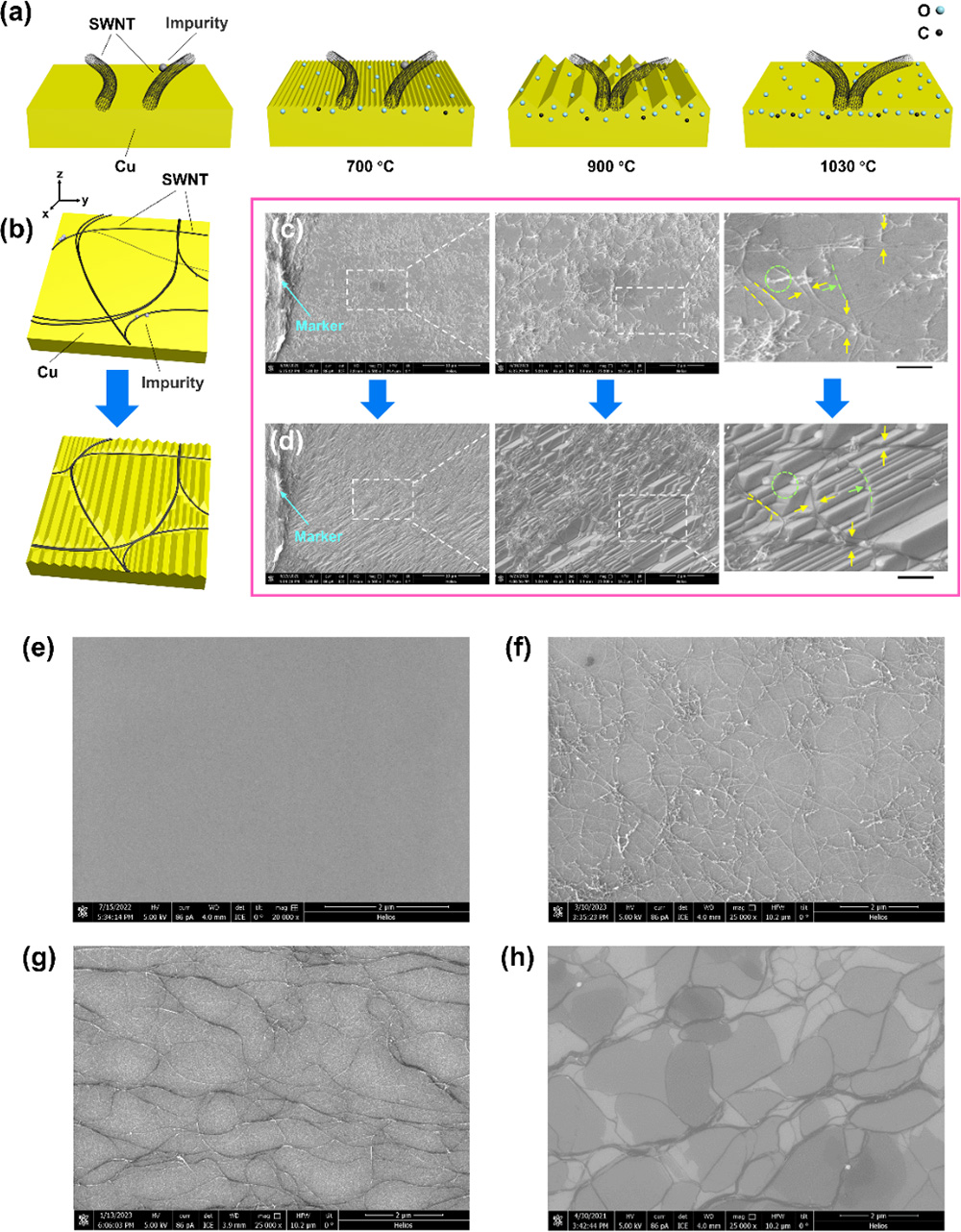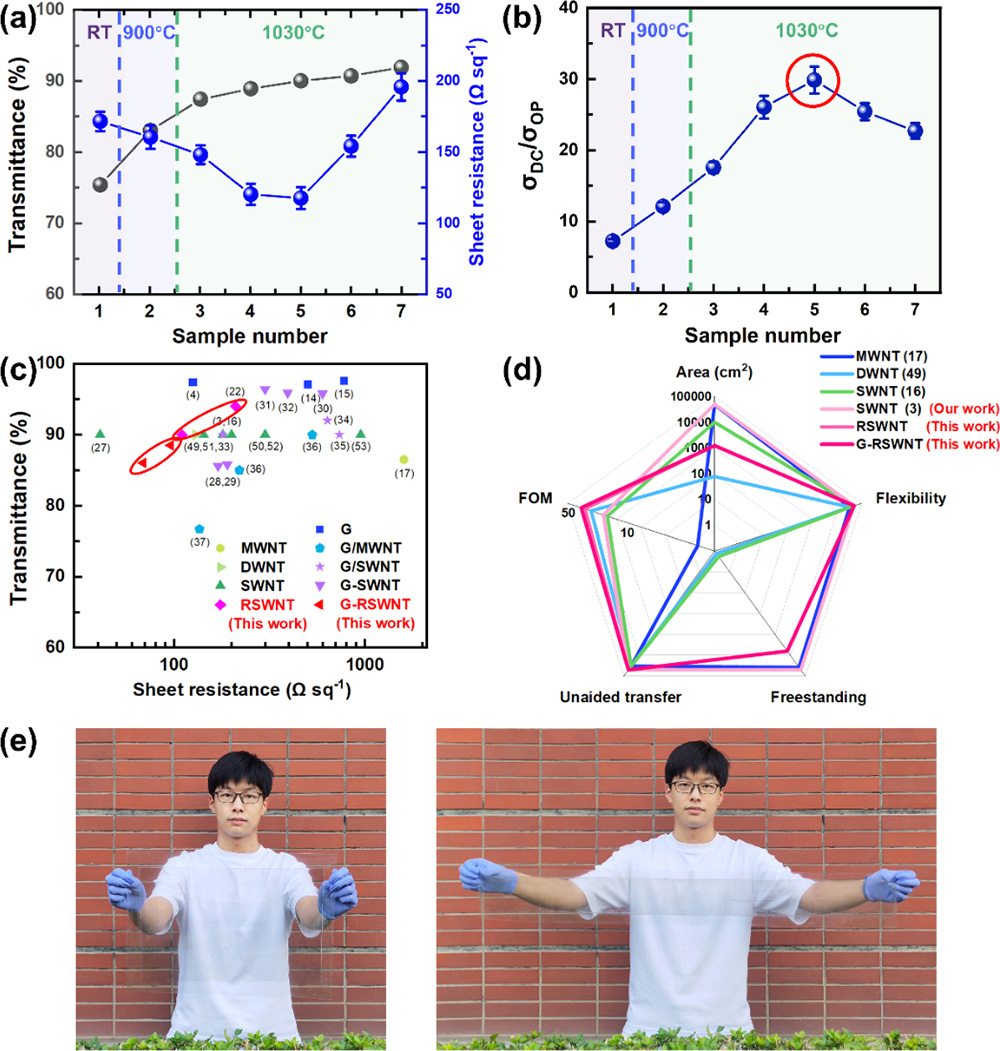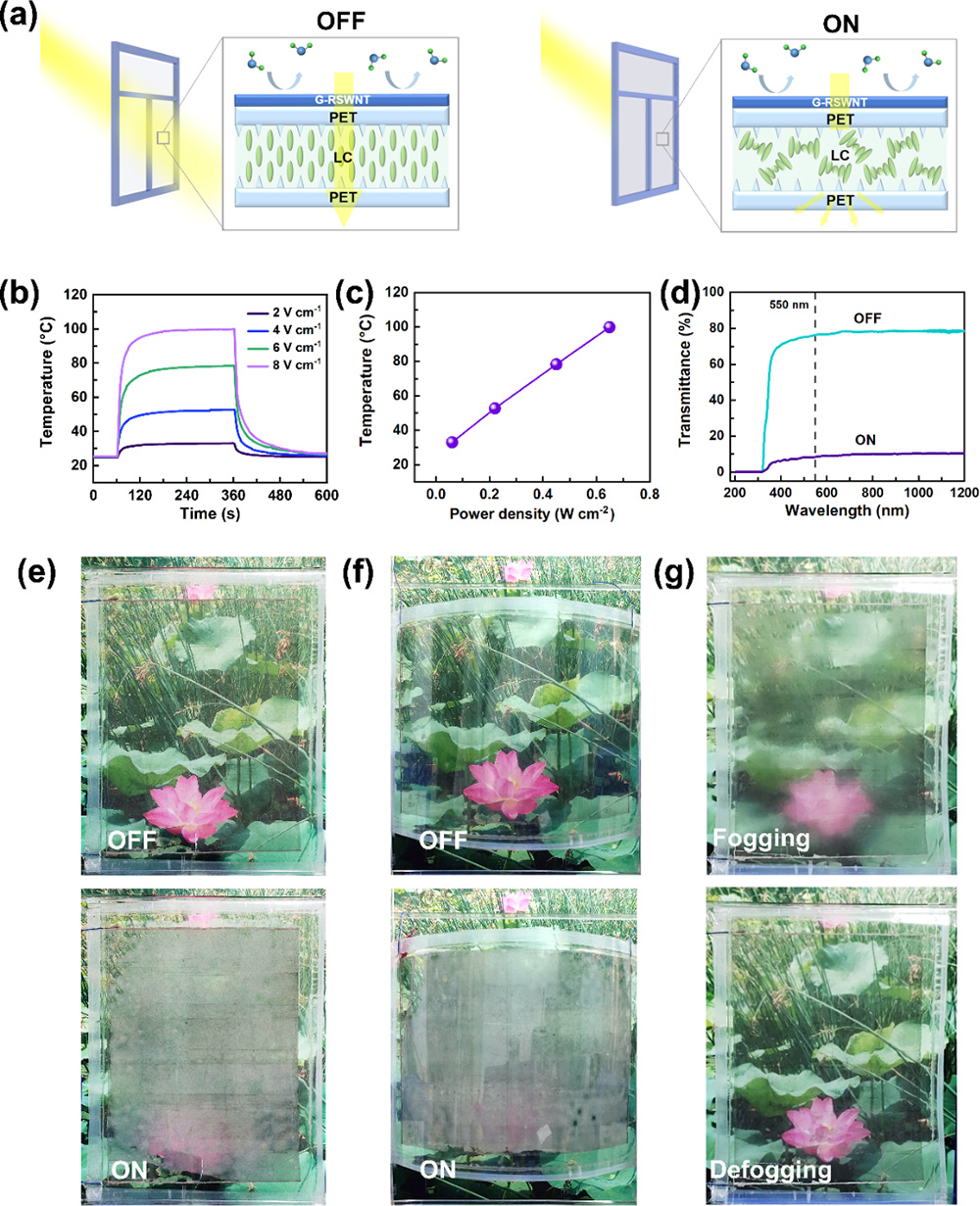Large-Area Preparation of Flexible Carbon Nanofilms with Synergistically Enhanced Transmittance and Conductivity
Date:21-05-2024 Print
Large-area flexible transparent conductive films (TCFs) are urgently in great demand for future electronics, optoelectronics, energy devices and other fields. Indium tin oxide (ITO) TCF, which is widely used in modern technology, is difficult to meet the needs of scientific and technological development (especially a new generation of flexible electronic devices), because indium is a non-renewable resource and expensive, and ITO is inherently brittle. Currently, carbon nanofilms, metal nanowires, conductive polymers and other transparent conductive materials have been developed to replace ITO. Among them, a carbon nanofilm is considered to be one of the most promising candidates due to the excellent electrical and optical properties, flexibility and excellent stability, as well as lightweight, radiation resistance and ultra-fatigue resistance which are particularly needed in future aerospace and military applications. However, the prerequisite for realizing the wide application of flexible TCFs requires not only that they overcome the mutual restriction between transmittance and conductivity, but also that they must be able to be prepared on a large area or even on a large scale. This is a knotty problem that has been puzzling researchers in the field of carbon nanomaterials and even in the field of TCF for many years.
The researchers in the "Nanomaterials and Mesoscopic Physics" research group (Group A05) at the Beijing National Laboratory for Condensed Matter Physics and Institute of Physics, Chinese Academy of Sciences, have been committed to the basic investigation on the preparation, properties and potential applications of low-dimensional carbon nanomaterials and nanostructures over 30 years, and have achieved a series of innovative important results. Recently, based on their developed freestanding transparent conductive carbon nanotube film (CNT TCF) continuously and directly prepared by the blowing aerosol method (Advanced Materials, 32, 2004277, 2020; Patent ZL 201310164499.5, ZL 201811117042.8, PCT Patent US 10,144,647 B2), in view of the above challenging problems, YUE Ying, a PhD candidate at the research group, under the supervision of Prof. ZHOU Weiya, proposed an advanced carbon nanotube network reorganization (CNNR) strategy, designed and developed an innovative facet-driven CNNR (FD-CNNR) technique, broke through the bottleneck of mutual restriction between the key properties of carbon nanofilms, and achieved the large-area fabrication and lossless transfer of CNT films. It provides an effective scheme to solve the "stuck neck" problem of large-area flexible TCFs.
Based on the unique mechanism of FD-CNNR technique, this work introduces an interaction between single-walled carbon nanotube (SWNT) and Cu–O reconfiguration for the first time, which allows the SWNT network to reorganize into a more efficient conductive path. Using this technique, large-area, flexible and freestanding reorganized carbon nanotube TCFs (RNC-TCF) with A3 size or even meter-length have been designed and prepared, including the reorganized SWNT (RSWNT) film and the hybrid film of graphene and reorganized SWNT (G-RSWNT) (the latter has an area of more than 1200 times that of the existing freestanding hybrid films reported). Moreover, the FD-CNNR technique enables these lightweight films to exhibit excellent flexibility, with synergistically enhanced high mechanical strength, outstanding transmittance and conductivity, and significant FOM values. The prepared large-area RNC-TCFs can be freestanding on the water surface and can be transferred to other target substrates without contamination and damage. On the basis of a large-area G-RSWNT TCF and a liquid crystal layer, a new flexible smart window with A4 size has been fabricated, with multi-functions such as fast heating, controllable dimming and defogging. The FD-CNNR technique can not only be extended to large-area or even large-scale preparation of TCFs, but also provide a new idea for the design of TCFs and other functional films. This work makes up for the shortcomings of the research in the field of large-area graphene-carbon nanotube hybrid films, and is expected to promote the large-scale preparation of large-area, flexible, freestanding, lightweight, and transparent conductive carbon nanofilms and their future applications in the fields of flexible electronics, photovoltaic devices, optical engineering, artificial intelligence, modern architecture, transportation, and even aerospace, and so forth.
The relevant research results have applied for Chinese invention patents. The research paper entitled "Large-Area Flexible Carbon Nanofilms with Synergistically Enhanced Transmittance and Conductivity Prepared by Reorganizing Single-Walled Carbon Nanotube Networks" has been published on Advanced Materials. PhD candidates ZHANG Di, WANG Pengyu, Dr. XIA Xiaogang, PhD candidates WU Xin, ZHANG Yuejuan, MEI Jie, Dr. LI Shaoqing, and PhD candidate LI Mingming have been involved in this research work, and received active cooperation and support from Prof. LIU Huaping, Senior Engineer WANG Yanchun, Prof. ZHANG Xiao, and Prof. WEI Xiaojun in this group. Here, the authors would like to express their special thanks and deep memory to Prof. XIE Sishen, academician of Chinese Academy of Sciences, the founder of the research group.
This study was supported by the Ministry of Science and Technology of China, the National Natural Science Foundation of China and the Chinese Academy of Sciences.

Fig. 1 (a-c) Photographs of freestanding G-RSWNT films floating on the water surface with 1m×10cm, A4 size, and A3 size, respectively. (d-g) Transmission spectra, sheet resistances, quality factors, stress-strain curves and Raman spectra of different carbon nanofilms. (Image by Institute of Physics)

Fig. 2 (a) Schematic diagram of the principle of FD-CNNR technique. (b) Schematic diagram of FD-SWNT reorganization mechanism. (c,d) In situ SEM images of the reorganization process, with scales of 10μm, 2μm, and 500nm from left to right, respectively. (e-h) SEM images of G, SWNT, RSWNT, and G-RSWNT, with scales of 2μm. (Image by Institute of Physics)

Fig. 3 (a,b) Parameter optimization of SWNT reorganization process. (c) Comparison of sheet resistance and transmittance of the present work with other reported carbon nanofilms. (d) Comparison of multiple properties of the present work with other reported carbon nanofilms. (e) Photographs of G-RSWNT TCF with A3 size and 1m×10cm transferred to PET substrate. (Image by Institute of Physics)

Fig. 4 (a) Schematic structure and principle of flexible smart window based on G-RSWNT film and liquid crystal layer. (b) Temperature variation of the smart window at different voltage densities. (c) The required power density of the smart window at different steady state temperatures. (d) Transmittance of the smart window in ON/OFF state. (e,f) Transparency change of smart window by voltage regulation at room temperature 25°C, spreading and bending states. (g) Defogging test at 20°C with smart window operating temperature of 28°C. (Image by Institute of Physics)
Contact:
Institute of Physics, Chinese Academy of Sciences
ZHOU Weiya
Email:wyzhou@iphy.ac.cn
Key words:
Flexibility; graphene and single-walled carbon nanotube hybrid films; large-areas; transparent conductive films
Abstract:
Large-area flexible transparent conductive films (TCFs) are highly desired for future electronic devices. Nanocarbon TCFs are one of the most promising candidates, but some of their properties are mutually restricted. Here, a novel carbon nanotube network reorganization (CNNR) strategy, that is, the facetdriven CNNR (FD-CNNR) technique, is presented to overcome this intractable contradiction. The FD-CNNR technique introduces an interaction between single-walled carbon nanotube (SWNT) and Cu─O. Based on the unique FD-CNNR mechanism, large-area flexible reorganized carbon nanofilms (RNC-TCFs) are designed and fabricated with A3-size and even meter-length. Synergistic improvement in strength, transmittance, and conductivity of flexible RNC-TCFs is achieved. A4-size flexible smart window is fabricated, which manifests controllable dimming and fog removal. The FD-CNNR technique can be extended to large-area or even large-scale fabrication of TCFs and can provide new insights into the design of TCFs and other functional films.

